Employee disengagement is a silent productivity killer.
It starts small.
Missed meetings, low enthusiasm, quiet Slack channels. Over time, it snowballs into turnover, burnout, and disconnection. In fact, Gallup reports that only 23% of employees worldwide are engaged at work. That means nearly 3 out of 4 people are just doing their jobs for the sake of it.
This disengagement can come at a cost. Low engagement doesn’t just affect morale, but also impacts everything else. Teams lose focus, innovation stalls, and your best people start quietly looking elsewhere.
HR leaders are stuck guessing: Is it workload? Leadership? Recognition? Without real-time insight, it’s impossible to fix what you can’t see.
That’s where employee engagement software platforms comes in.
These tools help you listen, measure, and act. And it gives you the data and direction to build workplaces where people feel seen, supported, and motivated.
In this article, we’ve rounded up the best employee engagement software of 2025 to help you better understand your people, improve culture, and turn insights into action.
Features to Look for in Employee Engagement Software
Choosing the right employee engagement software isn’t just about running surveys — it’s about finding a platform that helps you understand your people and act on what you learn. The best tools turn feedback into a continuous loop of listening, learning, and improvement. Here’s what to look for when evaluating your options:
1. Flexible Survey Capabilities
A great engagement platform gives you a variety of options. Look for one that supports multiple survey types: engagement surveys, pulse surveys, and performance review surveys. This helps you stay tuned to employee sentiment throughout the lifecycle, identify trends early, and respond before small issues become bigger ones.
2. Actionable Analytics and Insights
Data is only useful if it tells a story. Prioritize platforms that offer visual dashboards, sentiment analysis, and heatmaps. These insights help you pinpoint what’s driving engagement, and where it’s quietly slipping.
3. Recognition and Rewards Tools
Recognition is the heartbeat of engagement. Choose a platform that lets employees celebrate each other through peer recognition, badges, or value-based shoutouts. When appreciation is frequent and visible, morale rises, and performance follows.
4. Manager Dashboards and Team Reports
Managers are the front line of engagement. Equip them with real-time dashboards and team-level reports so they can track sentiment, spot early warning signs, and tailor their leadership approach.
When managers lead with context, teams thrive.
5. Follow-Up and Action Planning Tools
Collecting feedback is easy, but acting on it is where real change happens. Look for software that includes action-planning tools, ideally powered by AI. These features help teams create accountability loops and ensure every survey insight translates into measurable progress.
6. Anonymous Feedback Support
Honest feedback only happens when employees feel safe. Your engagement platform should offer anonymous responses and two-way anonymous conversations. This builds trust, encourages transparency, and gives you insights that surface nowhere else.
7. Integrations with Daily Tools
Engagement shouldn’t live outside the flow of work. Make sure your platform integrates with the tools your teams already use — like Slack, Microsoft Teams, or your HRIS.
That way, giving feedback, sending kudos, or checking insights becomes a natural part of the workday.
8. Mobile-Friendly and Frontline-Ready
Engagement shouldn’t stop at the office. For organizations with frontline or deskless employees, mobile access is a must.
Features like QR-code surveys, multilingual support, and lightweight interfaces make it easy for everyone to participate — no matter where they work.
9. Benchmarks and Comparative Data
Look for tools that include industry or internal benchmarks so you can compare engagement scores over time or against peers.
It’s how you identify what “good” looks like — and what’s worth improving next.
10. Scalability and Admin Controls
As your organization grows, your engagement platform should grow with you. Robust admin controls, role-based access, and customizable segments make it easy to manage feedback across departments and geographies without losing control or compliance.
Best Employee Engagement Software Platforms to Engage and Retain Your Employees
1. ThriveSparrow
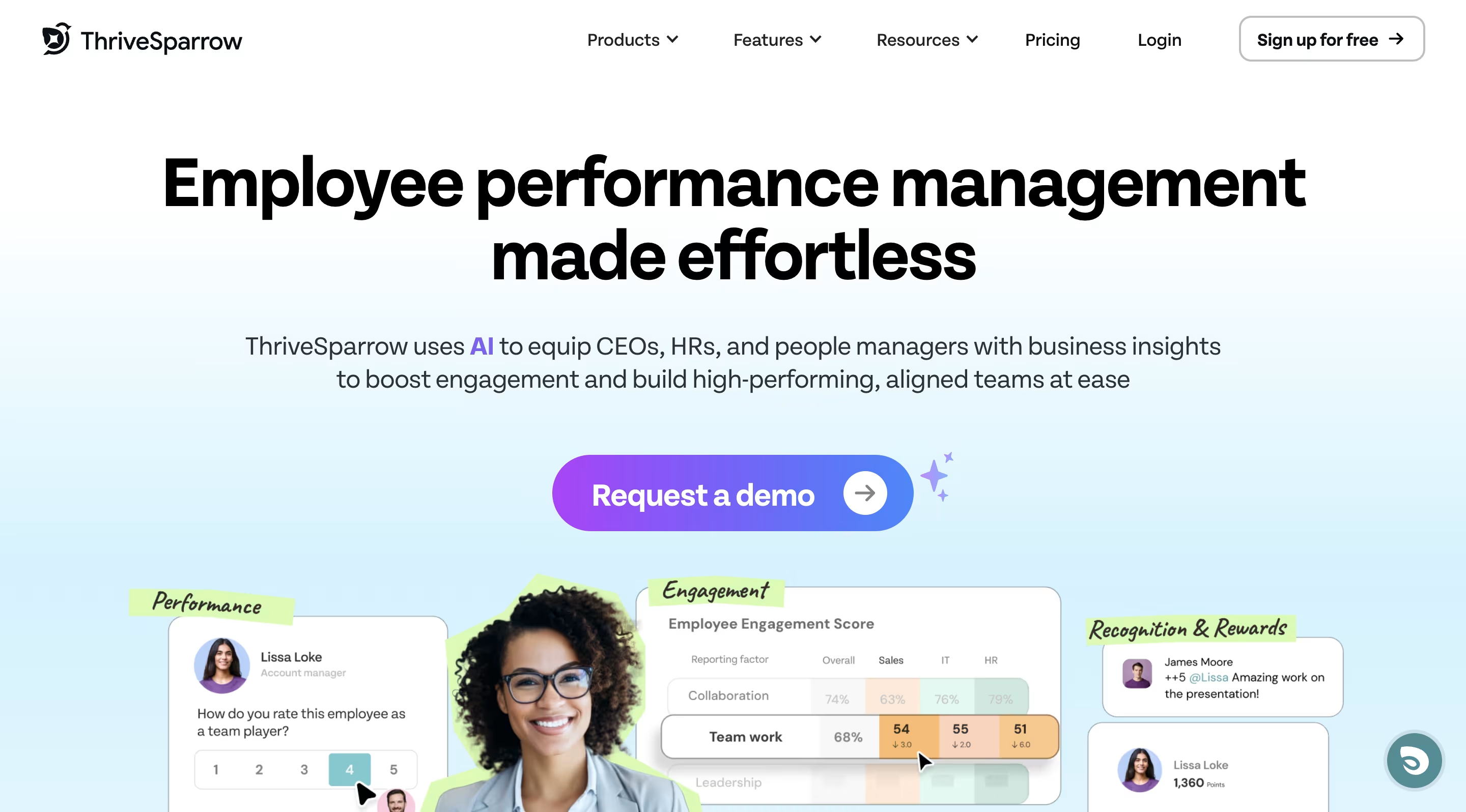
ThriveSparrow is an AI-powered employee success platform that brings together engagement, recognition, and performance management into one solution. The platform uses smart heatmaps and sentiment analysis to help companies spot teams that need support and create action plans that deliver results.
ThriveSparrow features
ThriveSparrow takes a modular approach to employee engagement with four core products:
- Engage: Capture employee feedback via eNPS and pulse surveys in over 100 languages. AI-driven sentiment analysis examines responses to reveal detailed insights about employee satisfaction.
- Kudos: Build a recognition culture through customizable appreciation cards and point systems. Teams can share kudos directly on Slack and Microsoft Teams for immediate recognition.
- Goals (OKRs): Track objectives with immediate projections that help teams match company mission. The system has goal cycles, tree views, and features that boost achievement.
- Performance: Coming soon but will offer 360-degree reviews with personalized development plans.
The platform's heatmaps show a panoramic view of engagement patterns across departments. Teams with low engagement scores become easy to spot.
ThriveSparrow pricing
Each module has a per-employee monthly cost when billed annually:
- Goals (OKRs): $3 per employee/month
- Performance: $5 per employee/month
- Engage: $3 per employee/month
- Kudos: $2 per employee/month
Companies can pick individual modules or bundle them based on their needs.
ThriveSparrow best use case
Small to medium-sized businesses looking for simple tools to boost morale and productivity will find great value in ThriveSparrow. The platform works best in places where peer-to-peer recognition and employee wellness matter most.
The platform's user-friendly interface and detailed analytics help HR professionals and team leaders in retail, hospitality, and small tech firms. Companies that want to fix engagement problems with targeted action plans instead of generic solutions will love how ThriveSparrow turns feedback into growth opportunities.
Explore ThriveSparrow for free today.
2. WorkTango
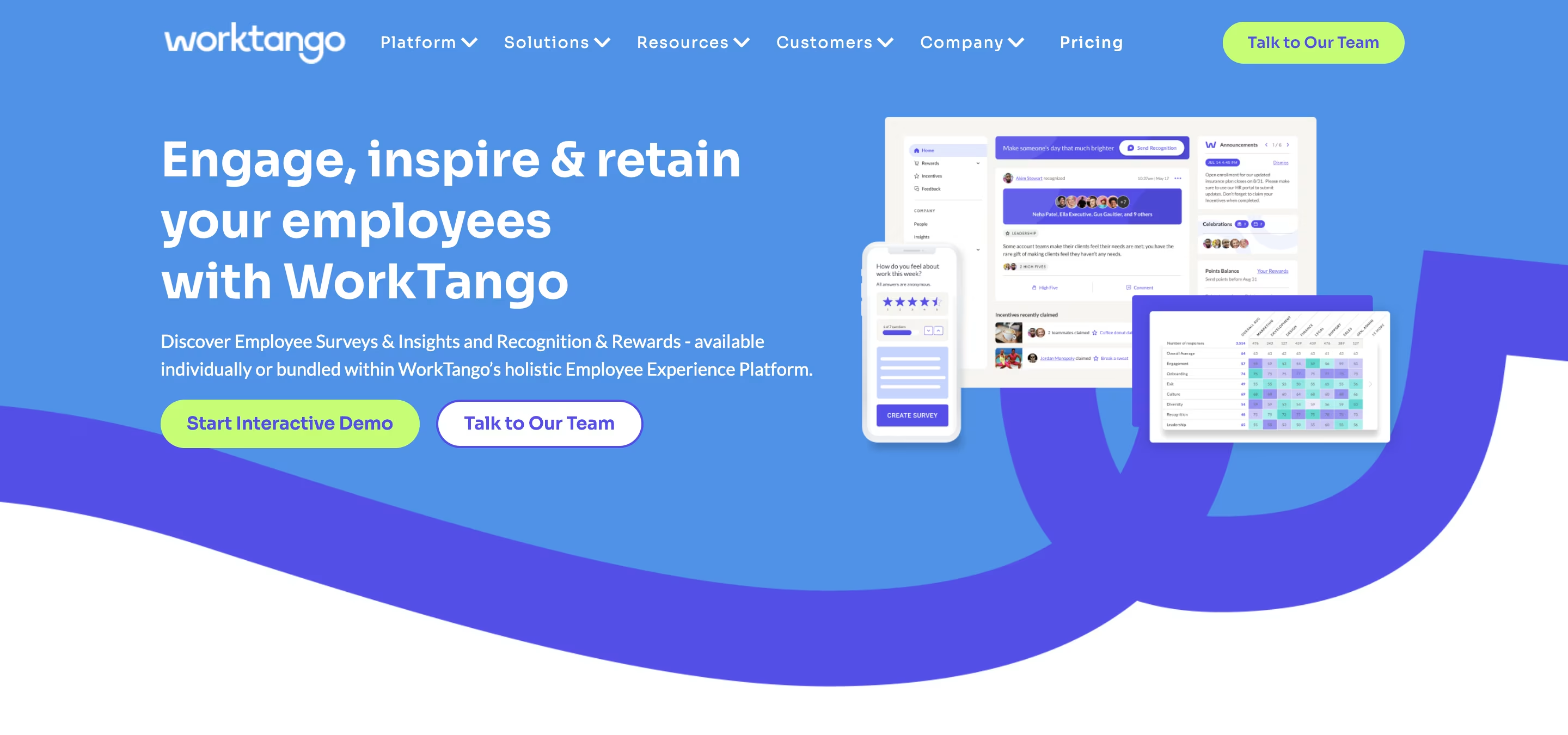
WorkTango makes employee recognition more evidence-based with its complete platform. This all-in-one solution merges employee recognition, feedback collection, and practical insights to build stronger workplace cultures.
WorkTango features
WorkTango's core has two strong solutions that work together or independently:
- Recognition & Rewards: The platform helps organizations of all sizes with peer-to-peer acknowledgments, milestone celebrations, and nominations tied to company values. Employees can share recognitions in a public feed with high-fives, comments, emojis, and GIFs. This makes appreciation visible throughout the company.
- Surveys & Insights: The platform lets you run unlimited surveys throughout the employee lifecycle with customizable templates for onboarding, engagement, and offboarding. Leaders can spot trends and hotspots quickly with up-to-the-minute dashboards that show results through sentiment clouds and heat maps.
The platform stands out with its zero-markup rewards marketplace offering over 10 million options—from brand-name products to custom company swag. The system also works with 40+ HRIS platforms and communication tools like Slack and Microsoft Teams.
WorkTango pricing
WorkTango has three distinct packages:
- Employee Surveys & Insights: Has unlimited surveys, customizable dashboards, and anonymous conversations
- Recognition & Rewards: Comes with peer recognition, zero-markup marketplace, and milestone celebrations
- Full Employee Experience Platform: Combines both solutions with integrated analytics and volume discounts
You'll need to contact sales for specific pricing, though one reviewer said it costs "less than a Starbucks latte per employee per month".
WorkTango best use case
Large organizations looking to combine multiple HR tools will find WorkTango extremely useful. Alarm.com's case study showed an 85.7% manager engagement rate after using the platform. Companies have also seen a 49% drop in turnover after adoption.
Organizations that need to measure engagement while building recognition programs will benefit most from this platform. WorkTango helps turn feedback into meaningful action throughout the employee's journey.
3. Culture Amp
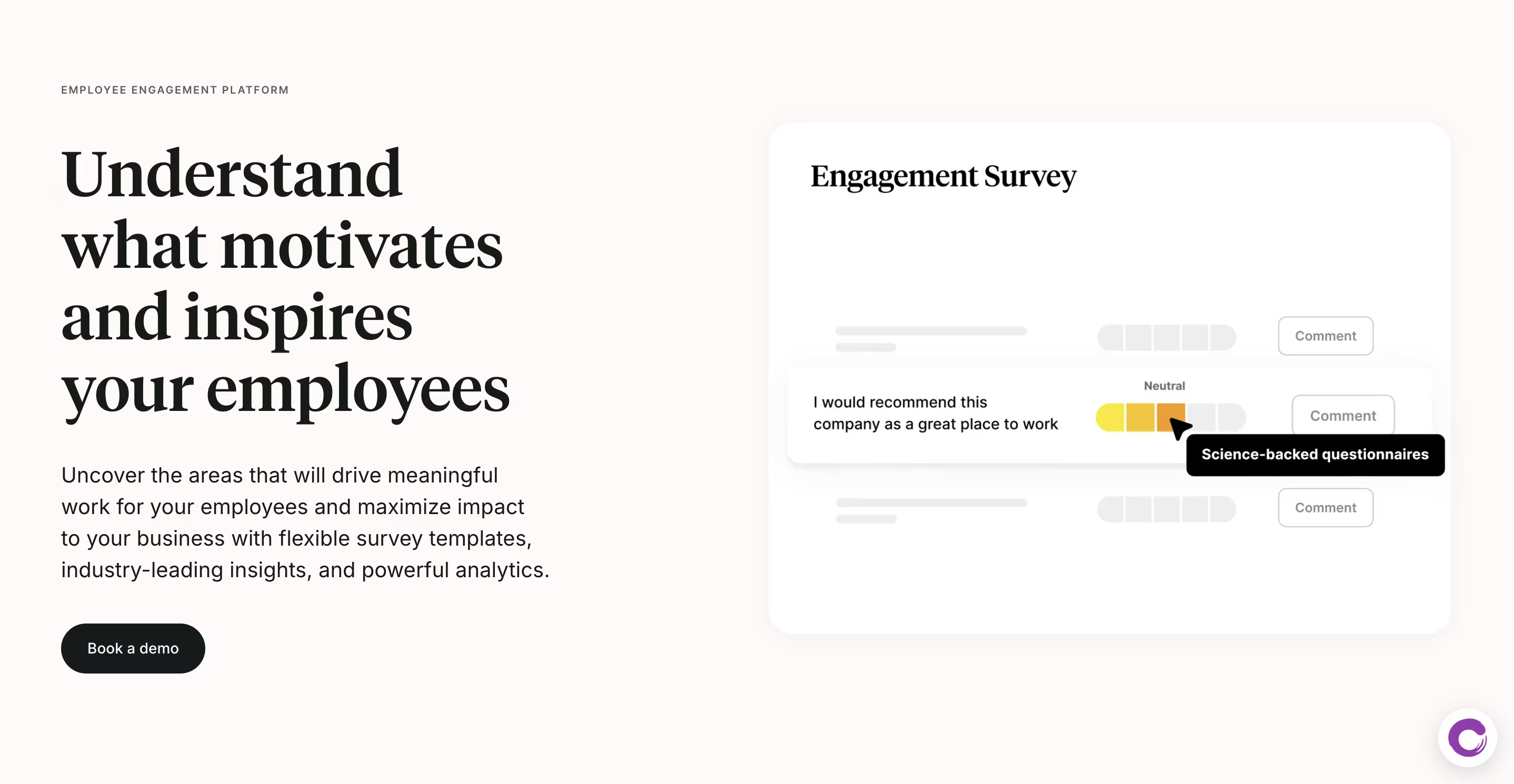
6,500+ companies trust Culture Amp as their go-to people science platform that transforms employee feedback into measurable business results. Culture Amp stands out from typical HR tools by blending organizational psychology with data science. This approach takes the guesswork out of building a thriving workplace culture.
Culture Amp features
The platform serves as a detailed employee experience solution with three key capabilities that work naturally together:
- Engage - You get access to 40+ science-backed survey templates crafted by data scientists and organizational psychologists. These templates measure engagement throughout an employee's journey. The platform sets industry standards with over 1 billion survey responses from different regions and industries.
- Perform - Teams grow stronger through continuous performance management tools. These include 1-on-1 conversations, goal tracking, instant feedback, and performance reviews. The platform has unique features like "Skills Coach" for daily learning and "Shoutouts" to recognize achievements.
- Develop - Employees thrive with career paths, competency frameworks, and tailored development plans that line up with business goals.
Culture Amp's standout feature lies in its powerful people analytics. The platform connects employee sentiment data with business metrics to show a complete picture of what drives engagement.
Culture Amp pricing
The platform uses a per-employee pricing structure with three main tiers:
- Enterprise (1000+ employees): USD 43,700-74,700 yearly. This tier comes with extra features like manager training, one-on-one coaching, and expert guidance
- Standard: USD 109-115 per user for engagement surveys and performance reviews
- Develop: USD 28-29 per user for career paths and development plans
Every subscription has core features such as multilingual support, HRIS integrations, SSO encryption, and enterprise-grade security.
Culture Amp best use case
Mid-to-large enterprises looking for informed HR solutions see the best results with Culture Amp. Companies using the platform achieve impressive results - they're 1.3x more likely to hit financial targets and 3x better at managing organizational change.
Companies that want deep insights into employee experiences while taking strategic action benefit the most. CEO Christian Gisy shares his experience: "We now have a continuous listening and action loop... allowing us to enable our managers with data".
4. Motivosity
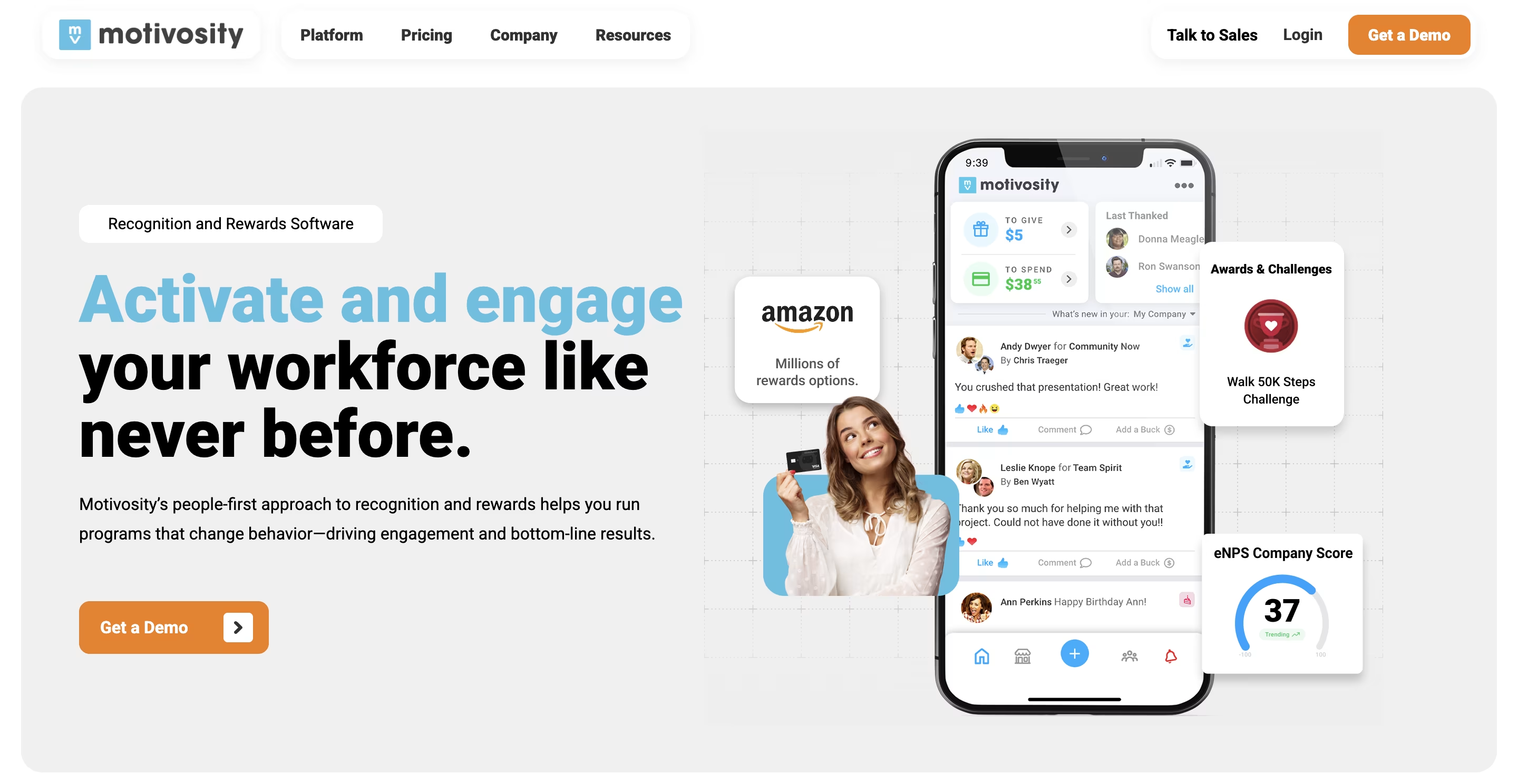
Peer recognition powers Motivosity's mission to build more united and engaged workplace cultures. Their all-in-one platform blends appreciation, rewards, and community-building. Recognition becomes a natural part of everyday work life.
Motivosity features
Motivosity provides complete recognition tools that encourage employee connections:
- Peer-to-peer recognition – Team members can share public thank you notes and add monetary rewards. This creates a culture where people appreciate each other and boosts team spirit across the organization.
- Automated milestone celebrations – The platform remembers birthdays, work anniversaries, and other special moments. It sends customized messages and rewards so no celebration gets missed.
- Social interaction tools – A central social feed, company org chart, announcements, and key updates help people connect. These tools work great for remote or hybrid teams.
- Customizable rewards marketplace – Team members can trade their recognition points for Amazon gift cards, charitable donations, custom catalogs, company swag, or ThanksMatters VISA cards.
- Resilient infrastructure – Continuous connection with Slack, Microsoft Teams, and various HRIS systems lets recognition happen where people actually work.
Motivosity pricing
Motivosity keeps pricing flexible with three main tiers:
- Standard – Minimum annual spend of USD 3000.00. This tier has core platform features like automated service awards, peer appreciations, global rewards, and social tools.
- Pro – You get challenges, nomination awards, spot recognition, bulk recognition, customizations, and a dedicated success manager.
- Custom – Budget-friendly solutions tailored to your business needs with personalized pricing.
You can buy individual modules separately starting at USD 1.00 per person per month.
Motivosity best use case
Motivosity shines in workplaces that need strong connections between scattered teams. Remote, hybrid, and multi-location companies benefit most from its social-driven approach.
Companies that make peer-to-peer recognition a priority see amazing results. Their employees feel recognized 3 times more often and twice as connected to their teams. These teams also have 2.3 times more people wanting to stay, even when competitors offer higher pay.
Small businesses with under 250 employees love the platform. They can build a culture of appreciation without drowning in administrative work.
5. Lattice
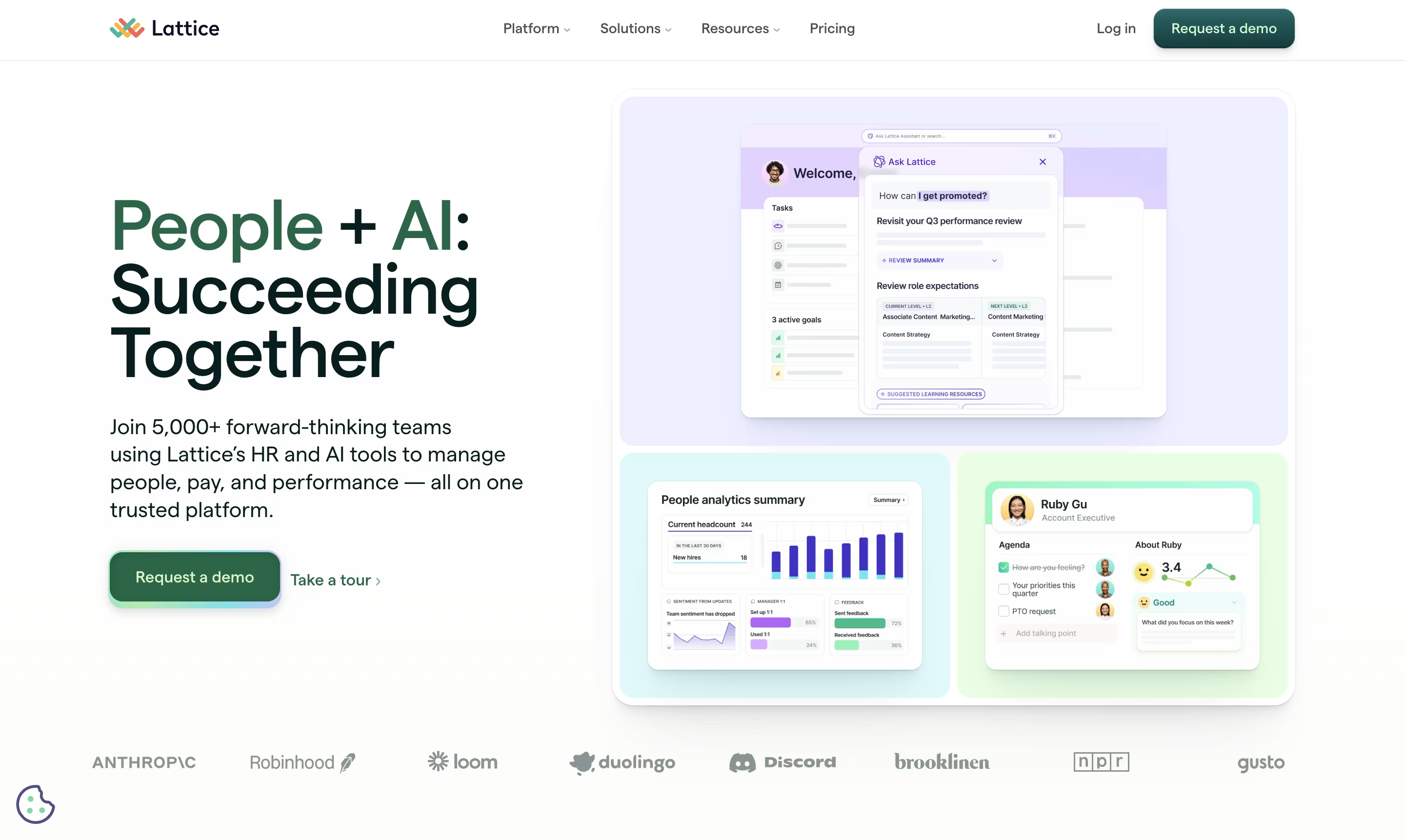
Lattice, a 5,000+ company strong HR platform, unites performance management, engagement, and career development into one ecosystem. The platform helps companies save 78% of administration time and has enabled organizations like Vantage West to reduce turnover by 27%.
Lattice features
Lattice provides a strong suite of HR tools that optimize people operations:
- Performance Management - Conduct complete reviews, succession planning, and performance improvement plans with customizable templates and workflows
- Engagement - Deploy pulse surveys, eNPS, onboarding/offboarding surveys with advanced analytics including heatmaps and sentiment tracking
- OKRs & Goals - Set and track objectives throughout the company with arrangement features
- Grow - Make career progression transparent with development tools
- Compensation - Design pay strategies that retain top talent
- Analytics - Access live insights with filtering capabilities by demographics, departments, or custom fields
Lattice stands out with its "Strong Anonymity" setting for surveys. This feature protects users from indirect identification through groupings, so respondents can share feedback more confidentially.
Lattice pricing
Lattice uses an annual billing model with a minimum yearly agreement of USD 4,000. Here's what the platform costs:
- Performance Management: USD 8.00 per user monthly
- Goals & OKRs: Approximately USD 10.00K per user
- Engagement: Add-on starting at USD 6.00K per user
- Grow: Add-on starting at USD 6.00K per user
- Compensation: Add-on starting at USD 8.00K per user
Their customer success team provides dedicated human support to help with onboarding and optimization for all contracts.
Lattice best use case
Mid-sized to large organizations that want to unite multiple HR functions into a single platform will find Lattice most valuable. The software excels especially when you have companies looking to connect engagement data with performance metrics to spot retention risks among top performers.
Companies using Lattice see major operational improvements. They optimize their review processes and career development pathways effectively. A customer explained it well: "Everything lives on that platform. If someone leaves the company or there's an org change, new managers can access historical data, unlike before when it was locked in personal email folders".
6. 15Five
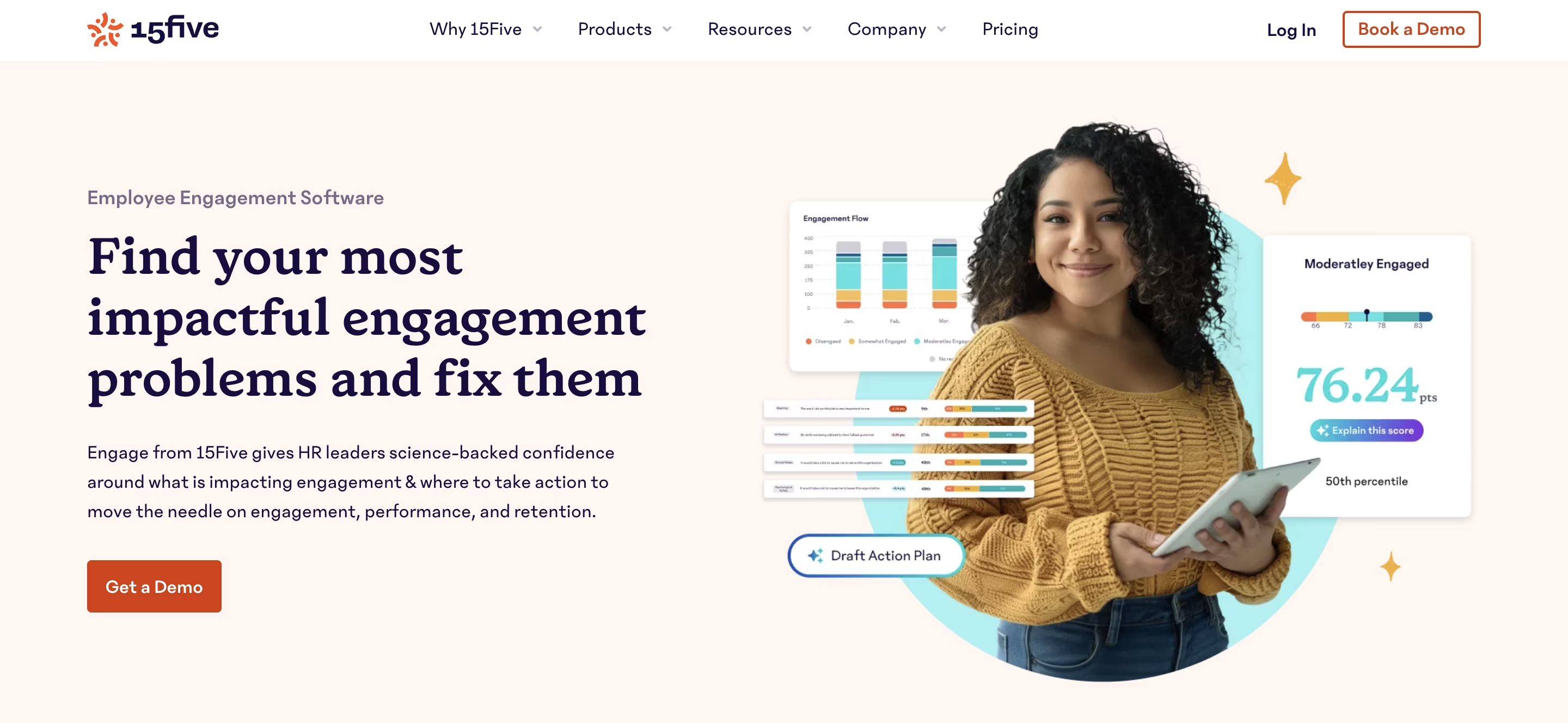
More than 3,000 organizations use 15Five to boost employee engagement, performance, and retention through its complete platform. The system works by deepening their commitment to the manager-employee relationship. This relationship forms the foundations of workplace success through continuous feedback and development.
15Five features
15Five delivers a resilient suite of interconnected tools that change how managers support their teams:
- Check-ins - Weekly reports take employees 15 minutes to complete and managers just 5 minutes to review. These reports replace traditional status updates with focused feedback
- 1-on-1s - Meeting tools that line up priorities and involvement by guiding discussions on priorities, challenges, and progress
- Engagement Surveys - These psychometrically validated assessments take only 6 minutes to complete from any device. They come with AI-powered Predictive Impact Model that shows which improvements will create the greatest effect
- Best-Self Review - Performance reviews boost growth through 360° feedback, competencies assessment, and calibrations
- Recognition - "High Fives" feature lets employees acknowledge peers' achievements either publicly or privately
The platform's real difference lies in its analytical approach to performance management. It turns insights into measurable growth conversations without relying on hunches or biased views.
15Five pricing
15Five has three main pricing tiers (billed annually):
- Engage: USD 4.00 per user monthly—with engagement surveys, standards, and AI-powered analytics
- Perform: USD 10.00 per user monthly—adds performance reviews, OKRs, goal management, and core platform features
- Total Platform: USD 16.00 per user monthly—combines everything in Engage and Perform plus the HR Outcomes Dashboard and select training modules
Transform packages for manager training start at USD 99.00 per manager monthly.
15Five best use case
Organizations that want to stimulate change through manager effectiveness choose 15Five. Users report achieving 94% retention rates after implementation.
The system works best for businesses moving from annual to continuous performance management. Managers make better decisions about promotions and compensation. Internal data shows that 63% of managers improve team engagement within thirty days of using the platform.
7. Reward Gateway

More than 1,900 companies worldwide trust Reward Gateway. This platform unifies employee recognition, communications, surveys, discounts, and analytics into one tailored hub. Your business becomes stronger when team members feel motivated through meaningful moments of appreciation that connect to your values and culture.
Reward Gateway features
Reward Gateway provides a detailed engagement toolkit that has:
- Customized recognition - Create tailored eCards, on-the-spot rewards, and milestone celebrations that reflect your unique brand and values
- Unlimited redemption options - Access immediate e-gift cards, Amazon integration with millions of products, custom company experiences, and charity donations
- Employee discounts - Save at over 900 retailers, including supermarkets, restaurants, travel, and entertainment venues
- Live analytics - Track platform usage with demographic segmentation to prove ROI and refine your engagement strategy
- Employee wellbeing center - Support mental and physical health with resources to manage stress and wellness activities
Reward Gateway stands out because of its 100% tailored design. No two platforms look alike, which makes your employer brand distinct.
Reward Gateway pricing
Reward Gateway has flexible pricing structures:
Monthly subscription: £8 per employee/month, cancellable anytime Annual subscription: From £6 per employee/month with volume discounts
Both options have employee discounts, recognition tools, wellbeing resources, 24/7 support, and a mobile app. Organizations with 100+ employees get customized solutions that include dedicated success managers and implementation teams.
Reward Gateway best use case
We see the best results in organizations that want to create unified workplace cultures across multiple locations. A client shared, "With multiple locations and staff so spread out, it's difficult to help them feel like they are part of our organization. This has helped our staff become more unified".
Companies looking to boost collaboration, recognition, and transparency see exceptional results. One user noted it "created a community of collaboration" while making the organization "much more positive" and "open".
8. Engagedly
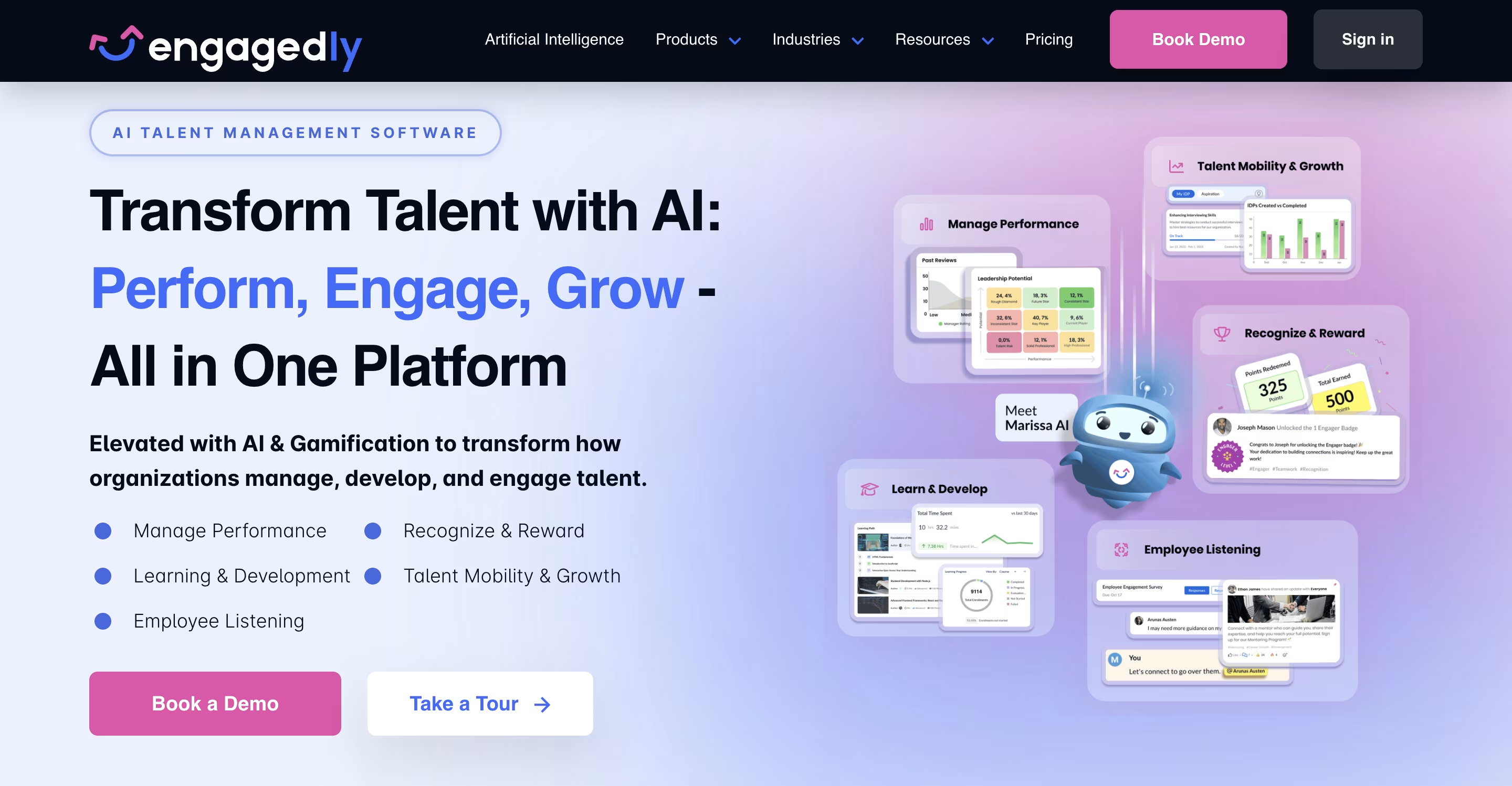
Engagedly's AI-powered talent management platform delivers impressive results. Their data shows that 86% of administrators save time on performance management tasks. This complete solution lifts employee performance, involvement, and development through five integrated modules that create a thriving workplace culture.
Engagedly features
The reliable platform combines multiple elements to improve workforce efficiency:
- Perform: Customizable review cycles with AI-powered 360° feedback, goal management, OKRs with predictive insights, and performance calibration via 9-box matrix
- Learn & Develop: Automated compliance training, tailored learning paths driven by AI and gamification that create a unified performance-learning ecosystem
- Engage & Listen: AI-powered engagement surveys with live analytics, continuous team pulse checks, and automated sentiment analysis to boost workplace connections
- Recognize & Reward: Gamified recognition system with AI-powered badge recommendations that line up with company values, customizable rewards marketplace, and public praise wall
- Talent Mobility: AI-driven skill tracking, tailored career pathing, and integrated ecosystem connecting learning, performance, and career development
The platform stands out with its E3 framework (engage, enable, execute). This creates continuous feedback mechanisms to improve collaboration across organizations.
Engagedly pricing
The platform offers flexible module-based pricing:
- Engage & Listen: USD 2.00 per user monthly (billed annually)
- Recognize & Reward: USD 2.00 per user monthly
- Learn & Grow: USD 4.00 per user monthly
- Manage Performance: USD 8.00 per user monthly
Organizations with 65 or fewer employees pay a flat USD 5000.00 annually with additional per-user fees.
Engagedly best use case
Mid-sized companies with larger budgets for talent management benefit most from Engagedly, especially in technology and finance industries where continuous feedback matters. The platform helps organizations connect engagement data with performance metrics through its complete analytics and workforce planning tools.
Companies that need strong succession planning will find great value in this platform. It helps identify high-potential employees and creates tailored development paths. The platform works best when companies want to move from annual reviews to continuous performance management.
9. Workleap Officevibe
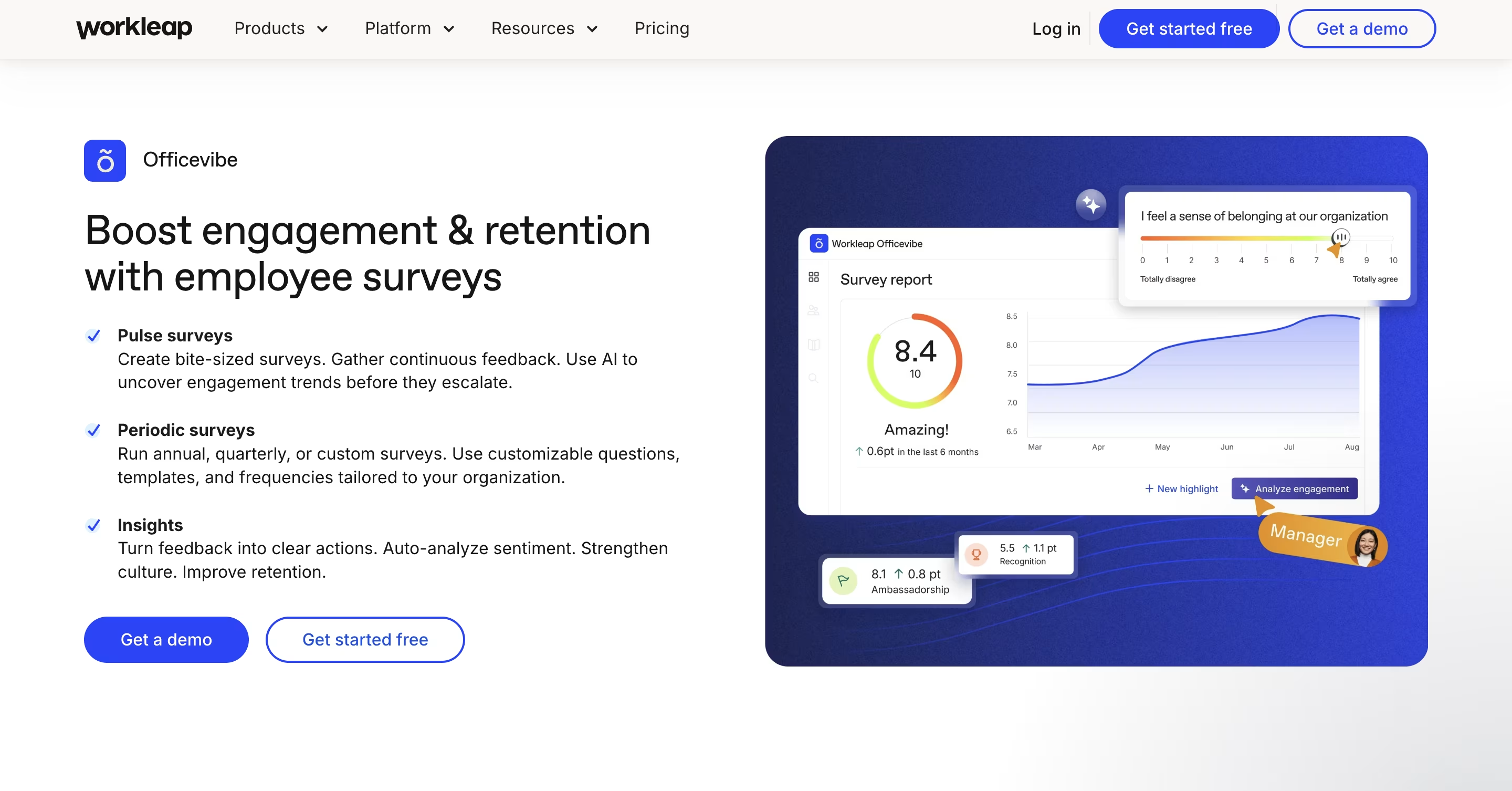
Officevibe's employee engagement platform by Workleap turns up-to-the-minute feedback into measurable improvements. Teams can share thoughts openly while managers get useful insights in a safe environment.
Officevibe features
The platform combines several tools that help boost workplace satisfaction:
- Pulse surveys – Ready-to-use, customizable, bite-sized questionnaires that naturally fit team workflows. These measure 10 key engagement drivers through 122 science-backed questions
- Anonymous feedback – A secure environment lets employees share honest thoughts without identification concerns
- Good Vibes recognition – Digital cards help celebrate wins with thoughtful shoutouts either privately or company-wide
- 1-on-1 meetings – Templates and reminders help turn conversations into action plans
- Goal setting – Tools for OKRs and goal planning that promote accountability and track progress
- Analytics dashboard – Detailed reports help spot trends and take proactive action
The platform also works smoothly with Slack, Microsoft Teams, and various HRIS tools.
Officevibe pricing
The platform offers three simple pricing tiers:
Free – $0/month with core reports, Slack/Teams integration, and email support
Essential – $5/user/month includes unlimited data history, advanced reports, engagement insights, and manager templates
Pro – $8/user/month adds onboarding surveys, data exporting, custom segmentation, and tailored onboarding (for 100+ users)
Schools and nonprofit organizations might qualify for special pricing.
Officevibe best use case
Small to mid-sized businesses looking to build stronger manager-employee relationships will find Officevibe most useful. Remote teams that don't deal very well with maintaining connections across distances find the platform particularly valuable.
Companies using Officevibe say it creates "a community of collaboration" and makes communication "much more positive" and "open." The platform's user-friendly design and anonymous feedback features work exceptionally well for organizations that want to build a continuous feedback culture where managers quickly address concerns.
10. Peakon (by Workday)
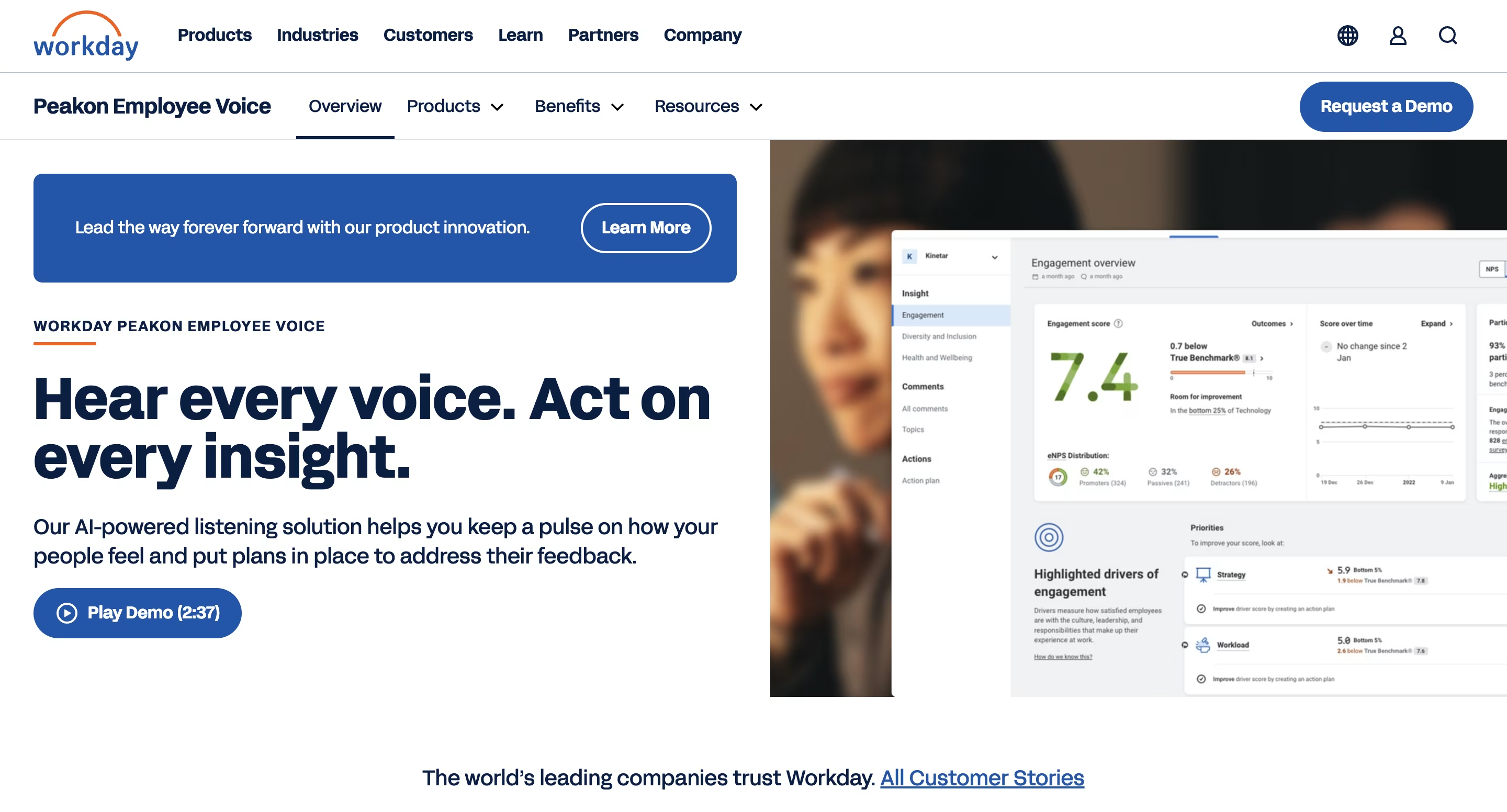
Workday Peakon Employee Voice turns raw feedback into business results through its powerful analytics platform. The platform has one of the world's largest collections of employee sentiment data—over 1 billion combined responses and 200 million written comments from 160 countries. This helps organizations predict when employees might leave and tackle important issues like burnout, which affects 27% of employees in typical organizations.
Peakon features
Peakon's detailed feedback system gives great employee insights through:
- Truly confidential surveys that get honest answers in 65 languages, letting employees share their thoughts safely
- AI-powered analytics with generative AI summaries that quickly spot key themes from huge amounts of feedback
- Predictive attrition modeling that helps spot which employees might leave
- Continuous listening technology through email, SMS, Microsoft Teams, and Slack, plus kiosk options for retail and manufacturing teams
- True Benchmark™ technology that accounts for demographic differences to get accurate engagement measurements
The platform also provides quick comment summaries by department or location, giving targeted insights right where you need them.
Peakon pricing
Workday Peakon Employee Voice costs around $20,000 yearly, making it an enterprise-level solution. Users rate its value at 4.4/5, which suggests it's worth the investment. You'll need to contact sales for exact pricing based on your organization's needs.
Peakon best use case
Peakon works best for medium to large organizations that want deeper workforce insights. The platform really shines in multinational companies because it supports 65 languages and lets you break down data by departments, locations, and other factors.
Companies with retention challenges see big benefits—Peakon shows that current employees typically have 20% higher engagement scores than those who've left. This makes it perfect for spotting who might leave soon. Organizations going through changes find Peakon helps them measure and maintain positive progress while boosting business results.
11. Leapsome

Leapsome is a people enablement platform that unites performance, engagement, and learning into one streamlined solution. It’s built for modern companies looking to align goals, foster feedback, and build continuous growth through AI-powered insights.
Leapsome features
- Performance Reviews & 360° Feedback – Run flexible review cycles with customizable templates and 360° evaluations to capture holistic performance insights.
- Goals & OKR Tracking – Set company-wide objectives, align personal goals, and visualize progress with transparent dashboards.
- Continuous Feedback & Recognition – Encourage real-time peer and manager feedback that builds a culture of appreciation and learning.
- Engagement Surveys – Capture employee sentiment through pulse and engagement surveys powered by AI-driven analysis and heatmaps.
- Learning & Development – Equip employees with personalized learning paths, onboarding modules, and skill tracking for professional growth.
Leapsome pricing
Starts around $8 per user/month, with modular add-ons such as engagement surveys or learning tools. Ideal for mid-sized businesses seeking structured growth and engagement.
Leapsome best use case
Best suited for companies focused on performance alignment and manager-employee development. Ideal for hybrid and remote teams wanting structured feedback, OKRs, and engagement in one system.
12. Workvivo
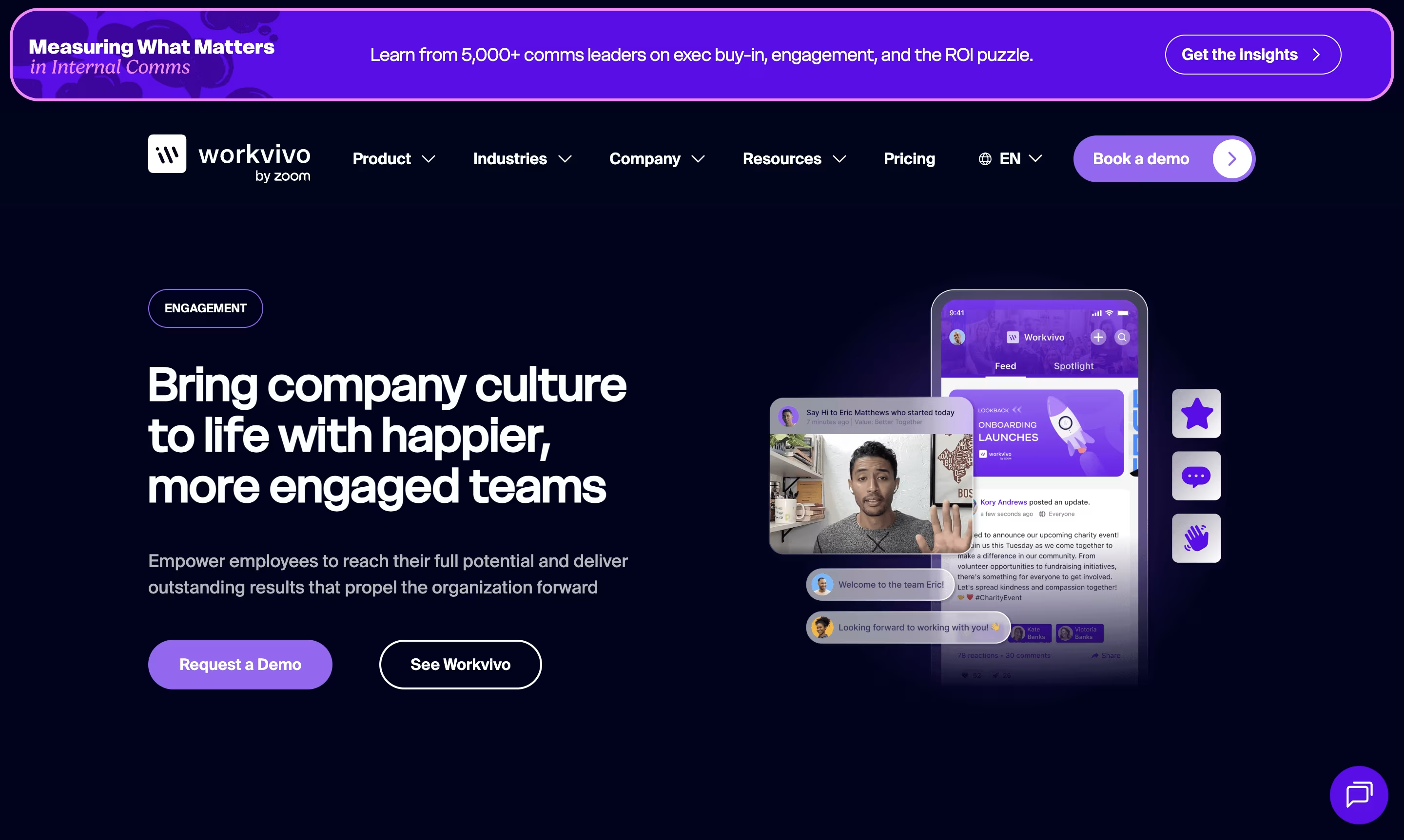
Workvivo, now part of Zoom, turns internal communication into a vibrant social experience. It bridges engagement and culture-building through a digital workplace that connects employees wherever they work.
Workvivo features
- Social Intranet & Newsfeed – Share updates, celebrate wins, and promote transparency through a social-media-like internal feed.
- Live Streaming & Multimedia Communication – Host company-wide announcements, town halls, or celebrations to strengthen community connection.
- Recognition Tools – Reward achievements with badges and shoutouts visible to everyone across the organization.
- Engagement Analytics – Access dashboards showcasing activity rates, sentiment data, and engagement health across departments.
- Integrations & Mobile App – Seamlessly connects with Zoom, Slack, and Microsoft Teams, offering full mobile access for distributed teams.
Workvivo pricing
Starts at roughly $20,000 annually, with a custom enterprise tier for large-scale deployments. Built for mid-to-large organizations that value community-driven engagement.
Workvivo best use case
Ideal for remote or hybrid teams looking to replace old intranets with an interactive platform that builds connection and visibility across departments.
13. Achievers
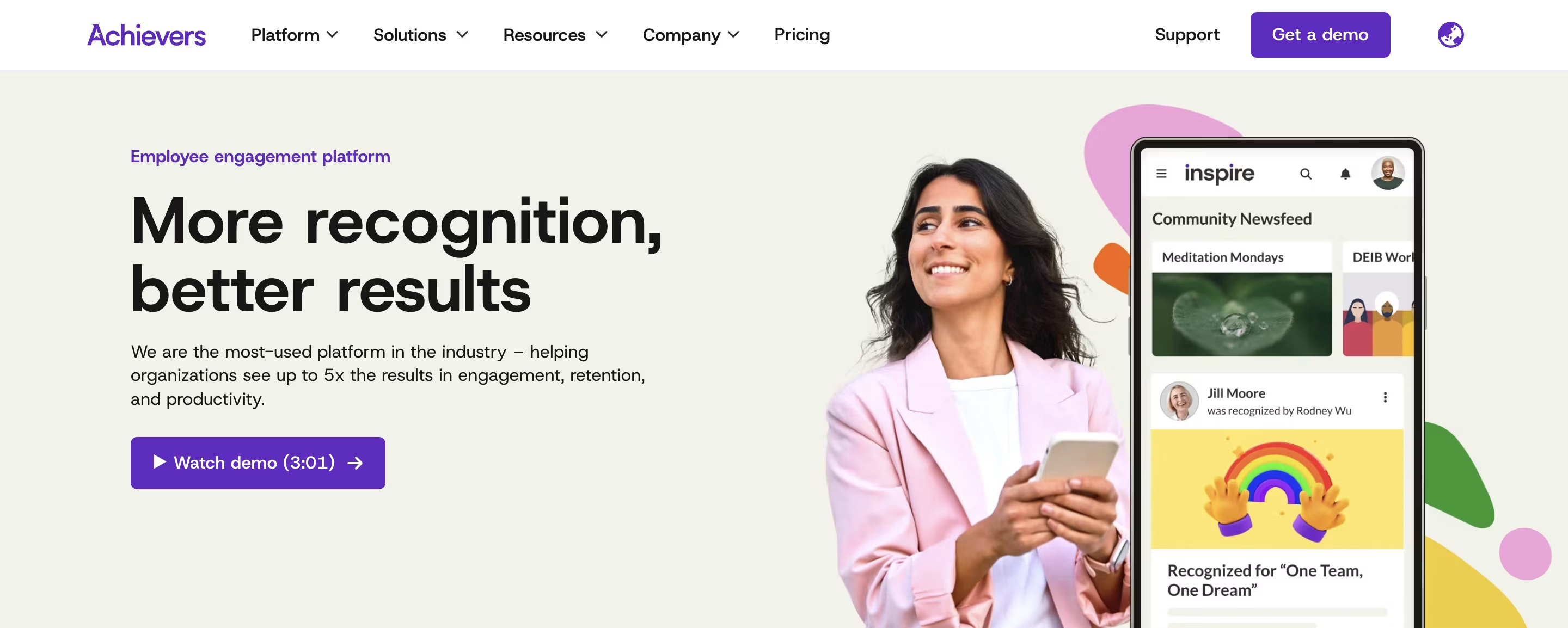
Achievers drives employee engagement through its powerful recognition and rewards ecosystem. The platform turns appreciation into measurable business impact with global reach and meaningful analytics.
Achievers features
- Recognition & Rewards – Enable peer and manager recognition with a points-based system and real-time visibility.
- Global Rewards Marketplace – Give employees access to millions of reward options across 150+ countries.
- Analytics & Insights – Track engagement trends, redemption patterns, and recognition activity to measure ROI.
- Feedback Tools – Run surveys and gather actionable feedback seamlessly integrated within recognition programs.
- Integrations & Mobile Access – Connects easily with HRIS, Slack, and Teams, while mobile access keeps global teams engaged.
Achievers pricing
Custom pricing based on organization size. Typical enterprise implementation starts around $25,000 annually with scalable user-based options.
Achievers best use case
Perfect for enterprise and global companies that want to unify recognition, boost engagement, and deliver consistent rewards experiences across regions.
14. HiBob
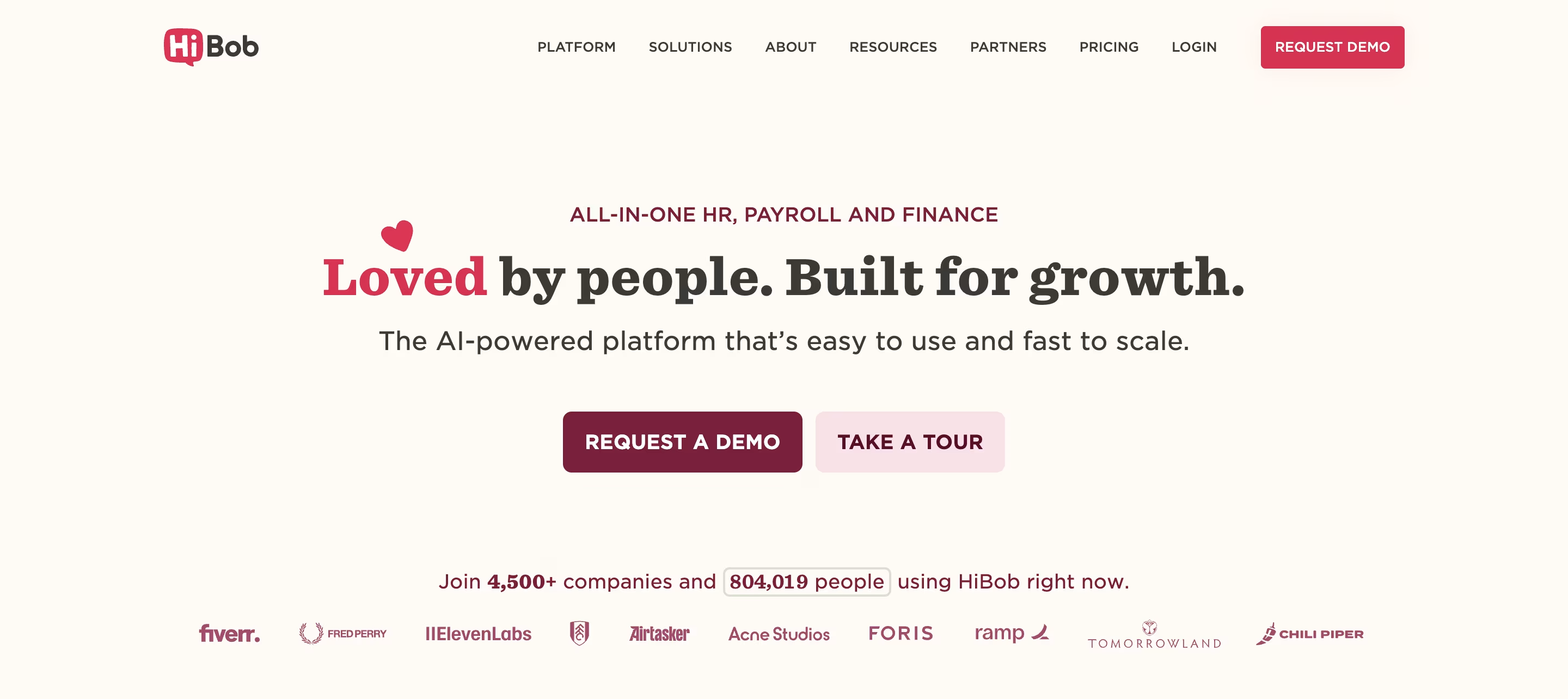
HiBob delivers a social network-like experience for HR functions. The platform achieves remarkable adoption rates because employees interact with it just like their favorite social media. This people-first HRIS system makes core processes easier. It prioritizes team connections regardless of where your workforce operates - in-office, remotely, or anywhere between.
HiBob features
HiBob's complete platform combines multiple capabilities to create a well-laid-out employee lifecycle solution:
- Core HR - A beautiful, easy-to-use interface centralizes global employee data, maintains compliance, and provides secure record management
- Culture tools - Team members can share updates through Shoutouts and recognize achievements with Kudos on a public feed
- Onboarding - The platform personalizes and automates onboarding with customizable checklists and optimized workflows that start before day one
- Performance management - The system enables 360-degree reviews with complete career timelines, activity tracking, and multiple viewpoints
- People analytics - Up-to-the-minute data analysis with KPIs, reports, and attrition indicators support strategic decisions
Bob has time tracking, compensation management, learning and development tools. It also offers anonymous feedback through "Your Voice".
HiBob pricing
HiBob bases its pricing on company size and selected features. Every plan has Core HR and Digital Admin fundamentals. Companies can add modules to create their ideal solution:
- Pricing varies with employee count and activated features
- Setup fees typically range from 10-20% of annual software costs
- Monthly cost per employee ranges from $16-25 PEPM
HiBob best use case
Small to medium-sized businesses with 50-500 employees get the most value from HiBob. Companies that need to support hybrid or remote work environments find Bob's engagement features particularly useful.
The platform works best for growing organizations that need adaptability. A customer summed it up perfectly: "We are growing, and the tool is growing with us". HiBob's focus on configurability makes it perfect for businesses who want to run HR their way instead of following rigid system requirements.
Benefits of Employee Engagement Tools
Employee engagement software is an engine that keeps modern workplaces connected, motivated, and performing at their best. These platforms give leaders real-time visibility into how people feel, why they stay, and where engagement drops off.
Employee engagement platforms help:
1. Spot disengagement early
Disengagement is a phenomenon where engagement doesn't vanish overnight, it fades quietly.
Employee engagement platforms have sentiment analysis capabilities that can catch that early dip in morale. This gives visibility into who's at risk of disengagement. With this insight, managers can take proactive steps in addressing issues early on without finding out about it in exit surveys.
2. Build open, two-way communication
More than just being heard, employees want to feel understood. Employee engagement platforms offers a space where your employees can voice their opinions.
And with anonymous capabilities, employees will be more inclined to give honest feedback.
3. Strengthen culture and belonging
A strong culture isn’t built in all-hands meetings, it’s built through daily moments of connection.
Engagement tools reveal what truly drives belonging in your workplace, whether it’s recognition, growth, or flexibility. With that clarity, HRs can design programs that are effective.
4. Reduce absenteeism through motivation
When people feel seen, they're more inclined to show up at work. Engagement platforms surface recognition opportunities and spot burnout triggers early.The result? Fewer sick days, higher energy, and teams that take pride in showing up.
5. Make decisions backed by data
Every feedback comment tells a story, and an engagement platform helps you read and analyze it.
Moreover, features like heatmaps, text analysis, and AI-driven insights enable leaders to see where engagement gaps exist and why. This data serves as a crucial element for executive-level decision-making.
6. Foster wellbeing and psychological safety
Engagement tools help HR teams monitor stress, detect burnout patterns, and create a space for honesty without fear.
7. Improve onboarding and retention
It takes only the first few weeks to make an impression in the company.
By collecting feedback from new hires, engagement platforms can uncover friction points you might never see. That insight helps you refine onboarding, build trust early, and turn first-day excitement into long-term commitment.
8. Give every voice equal weight
In great companies, everyone gets a voice — not just the confident few. Engagement tools democratize feedback, making it safe and easy for every employee, across regions or roles, to share their thoughts. That inclusivity fuels innovation and strengthens the collective voice of your culture.
Common Mistakes to Avoid While Choosing Employee Engagement Software
Finding the right employee engagement software can be a game-changer — but even experienced teams often trip over the same few mistakes.
Here’s how to avoid them and make a choice that actually drives lasting impact.
1. Expecting Instant Results
Many organizations roll out engagement software and expect overnight transformation.
But engagement isn’t a switch you flip — it’s a culture you build. The tool is only as powerful as the strategy behind it.
Pro Tip: Treat engagement software as a long-term partner, not a quick fix. Set realistic goals, track progress over time, and celebrate steady improvements rather than instant wins.
2. Rushing Implementation
A rushed rollout almost always backfires. Without clear onboarding or communication, employees see the platform as “just another HR tool,” not something built for them.
Pro Tip: Start small. Pilot with a team or department, gather feedback, fine-tune your approach, and then scale up. A thoughtful rollout sets the tone for adoption and success.
3. Ignoring Integrations
The biggest engagement killer? Tools that don’t talk to each other.
When data is scattered across spreadsheets, HRIS systems, and communication apps, insights get lost — and so does momentum.
Pro Tip: Pick a platform that connects with your existing tech stack — from Slack and Teams to your HRIS or payroll system. Integration keeps everything (and everyone) in sync.
4. Collecting Feedback Without Action
Asking for feedback and doing nothing with it is worse than not asking at all.
Employees notice when their input goes into a void — and once trust is broken, participation drops fast.
Pro Tip: Close the loop. Share what you’ve heard, outline what’s changing, and show results. Visible action builds credibility and keeps engagement alive.
5. Forgetting About Scalability
What works for 50 employees might crumble under 500. Many companies pick tools that can’t evolve with their growth — leading to costly migrations later.
Pro Tip: Choose software that scales with your needs. Look for flexible pricing, modular features, and strong admin controls that adapt as your team expands.
Emerging Trends in Employee Engagement Software [2025]
The employee engagement software landscape is evolving rapidly as we move through 2025. Here are the key trends reshaping how companies connect with their workforce:
1. AI-Driven Insights and Predictive Analytics
The most innovative engagement platforms now use artificial intelligence to do more than just collect data – they're actually predicting future workforce challenges before they happen. These smart systems analyze patterns in employee feedback, performance metrics, and even communication styles to flag potential burnout or flight risks, giving managers a chance to intervene before losing valuable team members.
2. Hyper-Personalized Employee Experiences
One-size-fits-all approaches to engagement are officially dead. Today's leading platforms create individually tailored experiences that adapt to each employee's unique work style, career aspirations, and personal motivations.
3. Holistic Wellness Integration
Mental health and overall wellbeing aren't just buzzwords anymore – they're core components of modern engagement strategies. Forward-thinking platforms now seamlessly incorporate everything from stress monitoring and meditation resources to financial wellness tools and sleep quality tracking.
Companies are finally recognizing that supporting the whole person – not just the professional side – creates more sustainable engagement and productivity.
4. Real-Time Feedback Mechanisms - That Help Prevent Turnover
Annual surveys are gradually losing popularity in the world of employee engagement. Many organizations are now emphasizing continuous, in-the-moment feedback collection. Features with comment analysis are making this possible.
This approach provides a much more accurate picture of engagement levels and allows companies to address issues while they're still small and manageable.
Wrapping Up
I believe that one of the options presented here, will set you on the path to turning your organization into an outstanding workplace.
However, always keep in mind that regardless of whether you opt for ThriveSparrow or any other platform, the real key to creating an exceptional work culture lies within 'you'. 😊
FAQs
1. How Do Engagement Platforms Work?
Employee engagement softwares operate by providing a suite of tools designed to enhance interaction between the organization and its employees.
Some of these tools include:
- Employee surveys
- Manager reports
- Team analytics
- Engagement and performance heatmaps
- Sentiment analysis
- Recognition channels
These tools facilitate real-time feedback, help recognize achievements, monitor employee satisfaction, and offer insights for improving engagement. These tools also help you collect data to analyze and improve your engagement strategies, fostering a more motivated and connected workforce.
2. How Important Are Employee Engagement Software Platforms?
Employee engagement software platforms can help people leaders enhance engagement and improve the organization's work culture, since:
1. They provide valuable insights into employee sentiment, allowing for more data-driven action plans and decisions.
2. They enable peer recognition that can foster greater levels of motivation and engagement.
3. They help curb turnover rates with the help of visual charts.
3. How Do I Measure ROI from Employee Engagement Software?
Measuring ROI from employee engagement software requires tracking both direct and indirect metrics. Start by establishing baseline measurements before implementation, then monitor changes in key performance indicators like turnover rates, absenteeism, productivity metrics, and revenue per employee.
Then combine these with survey data showing improvements in engagement scores, employee satisfaction, and team collaboration metrics. Many advanced platforms also provide built-in analytics that help quantify the financial impact of improved engagement over time.
4. Which Employee Engagement Features Are Most Important for Remote Teams?
For distributed workforces, communication and connection features are absolutely critical. Look for platforms with robust virtual recognition systems that make appreciation visible company-wide, along with pulse survey tools that can capture sentiment from employees regardless of location.
5. How Long Does Implementation Typically take?
Implementation timelines for employee engagement software vary widely based on company size, system complexity, and level of customization. For small to mid-sized organizations using cloud-based solutions with standard configurations, expect a 4-6 week implementation process.
Enterprise-level implementations with extensive customization, data migration, and integration requirements typically take 8-12 weeks. The implementation process generally includes initial setup, configuration, integration with existing systems, user training, and a phased rollout.
6. What are the privacy considerations when using employee engagement platforms?
Privacy should be a top concern when implementing any employee engagement solution. First, ensure the platform offers anonymity options for surveys and feedback, as employees need to trust that their honest input won't lead to retaliation or negative consequences.
7. Are Employee Engagement Platforms Suitable for Remote Teams?
Employee engagement platforms are particularly beneficial for remote teams.
Some platforms come with in-built recognition spaces where peer-recognition can be facilitated from anywhere. Moreover, wellness, pulse, and engagement surveys can be created and scheduled from anywhere without having the need to use traditional methods like paper.
Integrations for Slack and Google Workspace make communications easy on-the-go through community spaces.
















